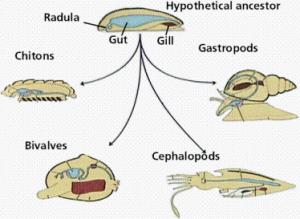As part of our GL2019 module in UCC on Palaeobiology, we were asked to create a website on a subject of our choice. After much deliberation we decided on bivalvia due to their interesting fossil record, evolutionary trends and basic anatomy. Of all invertebrates molluscs have arguably the widest range of body forms. They include gastropods (slugs and snails), bivalves (such as oysters and clams), cephalopods (octupuses, squid and cuttlefish among others). All molluscs have one of the following: a horny, toothed ribbon in mouth (the radula) that is unique to molluscs: a calcium-carbonate shell or other structure covering the upper surface of the body: and a mantle or mantle cavity, typically with a characteristic type of gill.

- Figure 1: The Variety of Molluscs.